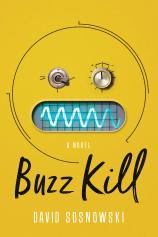Buzz Kill
Review
Buzz Kill
BUZZ KILL is a brilliant novel, a stunning demonstration that all comedy is a skewed perception of tragedy. David Sosnowski also presents extraordinary evidences of several inconvenient truths: (1) The moment we're born, we start to die; (2) We and our babies, our creations, are ourselves the deadly viruses that lead us inexorably to our own destruction; and (3) The best-laid schemes, even the innocent ones, of mice and men and machines oft go awry. Not a very happy trio of truths, but all essentially inarguable.
The author's writing and the depth and breadth of his knowledge will almost surely impress his readers as a shining display of a unique talent. BUZZ KILL features a detailed exploration of a dazzling array of topics --- the promise and problems of artificial intelligence and technological achievements in general; the horrors of mind-killing diseases; the hills and valleys of personal relationships, both romantic and familial; the sad realities of the autism spectrum and depression; the mysteries of consciousness and the mind; the dangers and evils of unchecked capitalism; and the beauties and vagaries of genius.
But that veritable flood of obviously careful research plus knowledge and wisdom doesn't really sufficiently describe the excellence of the novel. On each page, for example, there appear to be enough delicious metaphors to satisfy the appetites of even the most voracious poetry consumers. Some of those creations are hilarious, some are deadly serious, and all seem to flow so naturally from Sosnowski's imagination that they make literary mincemeat of our usual mundane collections of plain old prosaic pronouncements.
"BUZZ KILL is a brilliant novel, a stunning demonstration that all comedy is a skewed perception of tragedy.... [I]ts real pleasures arise from a deliberate and careful reading of the fascinating, funny and thought-provoking items and ideas that grace each page."
So be forewarned that BUZZ KILL is no page-turner. You are unlikely to feel that you can hardly wait to see what happens next. Instead, its real pleasures arise from a deliberate and careful reading of the fascinating, funny and thought-provoking items and ideas that grace each page.
There are two main characters and several other almost equally important ones. The first two are "messed-up" kids, Pandora Lynch and George Jedson. The names of both are, of course, reminiscent of fictional characters and are germane to the novel's themes. Both are geniuses; both are slightly or more off-kilter; both have been obsessively fascinated with computer technology since they were toddlers; and both are committed to the mission of creating an AI that will (a) pass the Turing Test (that is, essentially be able to convince those with whom it communicates that it is a human being), and (b) change the world for the better, with the specific goal of stopping teen suicides.
Pandora's dad, meanwhile, is a professional therapist who unfortunately has witnessed the suicide of a teenaged patient during a session with the boy. So now, he will see patients only online. And George is an orphan who, through a set of rather crazy circumstances, is hired by a multi-billion-dollar tech corporation whose primary goal is to end the tragedy of teen suicide through the wonders of technology, specifically AI. Pandora's dad also works for that corporation. So Pandora and George meet quite by accident via computer communication. They begin a virtual love affair and together pursue their mutually intense desire to build the ultimate save-the-world AI.
Anything else I might reveal here about that internet Romeo-and-Juliet star-crossed romance would constitute a major spoiler, so we'll end that particular plot summary right now and proceed to a sub-plot that is every bit as satisfying as the love story. This one involves two very important characters: Pandora's grandma, Gladys, and the kids' AI creation, Buzz. Gladys shares some of Pandora's facial physical characteristics, and, like Pandora, is quite brilliant and outspoken. But as the novel progresses, Gladys gradually succumbs to the ravages of dementia. Her intelligence and her very consciousness relentlessly fade to absolute zero. At the same time, Buzz's intelligence and consciousness are equally gradually building from zero to somewhere beyond our relatively primitive comprehension. The two characters are perfect mirror images of each other, a simultaneous crescendo and decrescendo of life as we perceive it, and as we struggle valiantly but futilely to understand it.
In addition to all that material to chew on, we should consider the book’s title. BUZZ KILL is itself a fine and scary example of literary foreshadowing. These two words taken together form a clue to the novel's most important plot threads as well as the gloom-and-doom --- and humorous --- black cloud that follows all the characters around for the moody majority of the piece. We are immediately afforded a clear glimpse of exactly where we are headed. And it isn't pretty.
Sosnowski, then, provides us fair warning not only about the end of the novel, but about our future or lack of same. That future, in other words, may be best described as oblivion. The author graciously provides us with a problem without a solution. He takes us on a journey through the bumpy and hazardous lands and mysteries of consciousness and artificial intelligence, the evils of Pandora's box, and the improbable cartoon of George Jedson's future world. And he guides us merrily down that road to the exit ramp that leads us to our own disappearance. But with Buzz firmly implanted in our brains, we exit laughing
Reviewed by Jack Kramer on May 15, 2020
Buzz Kill
- Publication Date: January 28, 2020
- Genres: Fiction, Humor, Science Fiction
- Paperback: 459 pages
- Publisher: 47North
- ISBN-10: 1542005043
- ISBN-13: 9781542005043




